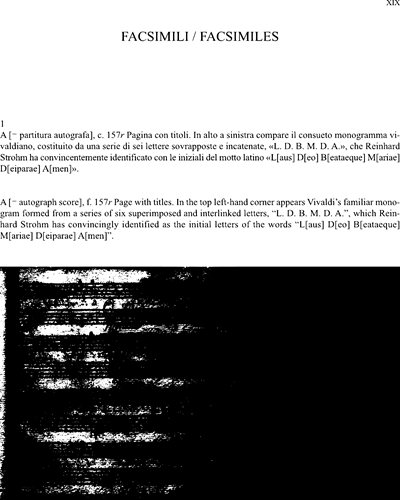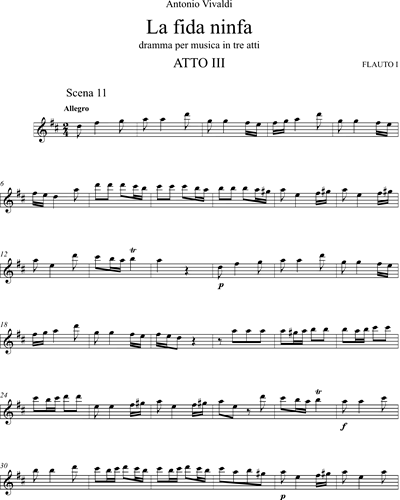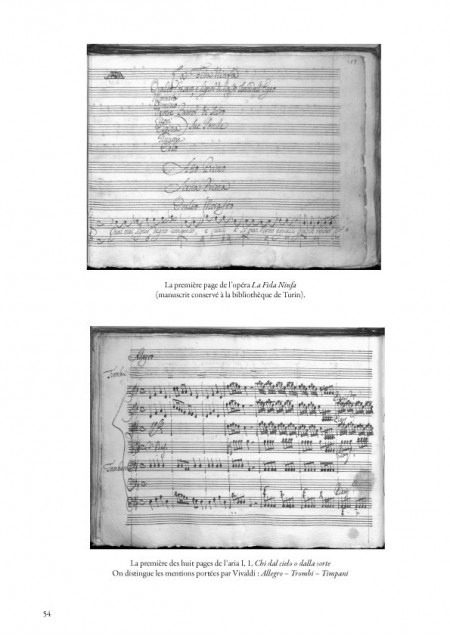Antonio Vivaldi wrote La fida ninfa on a tight deadline, having replaced the original composer late in the day. The opera was commissioned to inaugurate the Teatro Filarmonico in Verona and its 1732 première was a resounding success. The driving force behind the new theatre, respected historian and influential dramatist Scipione Maffei, also co-financed the extravagant production and stellar cast. Maffei also penned the libretto, whose overwrought plot taxes credibility, even allowing for contemporary conventions. Besides Licori, the universally desired titular nymph, there is her sister and rival Elpina, their shepherd father, and two brothers with the same name. They are all kidnapped at some point, because the plot needs them to converge on the island of Naxos, which is ruled by an explosive pirate-tyrant.
La fida ninfa (The Faithful Nymph, RV 714) is an opera by Antonio Vivaldi to a libretto by Scipione Maffei. The opera was first performed for the opening of the Teatro Filarmonico in Verona on 6 January 1732. Among the arias is Alma oppressa de sorte crudele (Soul oppressed by cruel fate). VIVALDI, A.: Fida ninfa (La) Opera (Opera teatrali, Vol. Listen to Vivaldi: La fida ninfa by Ensemble Matheus on Deezer. La fida ninfa, RV 714, Introduction: I. Allegro, La fida ninfa, RV 714, Introduction: II. La fida ninfa, RV 714 (Vivaldi, Antonio).
At home in Skyros, Licori once promised herself to Osmino. Torn apart, they meet years later, but she does not recognise him, chiefly because he now goes by the name Morasto. She falls in love with a shepherd, who later turns out to be Osmino’s younger brother, chiefly because their parents had renamed him Osmino. Meanwhile, back at the olive grove…
The flummoxing plot is redeemed by Vivaldi’s exquisite score, one long enchanting pastorale, which has survived intact, except for the opening sinfonia. Last Saturday, the opera’s Dutch première borrowed the stirring sinfonia from Bajazet. La fida ninfa combines instantaneous melodic appeal with deeply felt sentiment. Heartache, jealousy, homesickness: Vivaldi captures their essence with an economy of harmonic colours that keeps the music buoyant. Unusually for the time, he also adds a trio and a quartet, and flavours proceedings with a number of short arias. Conducting from the harpsichord, Andrea Marcon chose unhurried tempi that allowed the score to exhale its sensuousness. The musicians of La Cetra played with elegant precision and, when things became fast and furious, retained crisp rhythmic articulation. Nothing ever felt rushed or sluggish. The supple strings had a rosily warm sound, and the solos were one delight after another, from the molten horns in the overture to the sparkling theorbos.
The allure and pathos of the title role stemmed from María Espada’s soft, round soprano. Although her coloratura was impressive, her voice lost its contours the higher and faster it went, and lyrical moments such as the deeply dejected “Amor mio, la crude sorte” suited her best. Franziska Gottwald was a vivacious Elpina, especially nuanced in the recitatives. In her arias she wielded her compact, dark-brown mezzo with style and technical assurance. Equally perceptive with the text was Topi Lehtipuu as the sisters’ father, Narete. The tenor gets the longest aria, the plangently gorgeous “Deh, ti piega, deh consenti”, in which Narete begs the corsair to free his family. With his youthful, gracile voice Mr Lehtipuu was a sweet-toned Narete, although his vocal emission was uneven and some of his runs over-aspirated.


As Morasto, Roberta Invernizzi cleared all obstacles in her technically demanding part, completing a veritable coloratura marathon in “Destino amaro”. Her tangy, well-projected soprano gained tragic undertones as her character was overcome with despair and her suicide aria “Dite, ohimè, ditelo al fine”, with tearful theorbo accompaniment, was sublime tenderness. Luca Tittoto’s bronze-coloured bass had the right heft for Oralto, the pirate everyone loves to hate. He handled the wide range of the part with ease, and blustered heroically through his fury-fuelled arias. But this tyrant burns with love as well as ire, and Mr Tittoto also had the required mellowness. Countertenor Carlos Mena gave an all-round superb performance, investing the younger brother, Osmino, with brazen confidence and a vigorous vocal presence. His love aria “Ah! ch’io non posso lasciar d’amare”, was a demonstration of the expressive power of the da capo aria: 1. Let an accomplished singer lance through to the emotional centre in the first part. 2. Let him pull the audience into the character’s thought whorls in the middle section. 3. Let him further dissect the emotional kernel in the third section, making the audience forget they are listening to a reprise with variations, attaining such a degree of intimacy that they almost feel they are intruding. 4. Expect wonderstruck applause.
After all the muddles are cleared up and Licori is reunited with the right Osmino, the nymphs and shepherds decide to sail home, but a storm threatens their safety. Übergoddess Juno herself descended to the rescue in the shape of regal-voiced Romina Basso. The deus ex machina was accompanied by tempest music and much rumbling on the thunder sheet. Her secret weapon, Aeolus, commander of the winds, was a sonorous Ismael Arróniz holding his own against a raging wind machine. At this point, one wished someone would stage this opera, just for the special effects, although, as this performace proved yet again, Vivaldi’s music is pure pageantry. Many in the audience will be looking forward to more Vivaldi under Andrea Marcon next season at the Concertgebouw, when Roman republicans and imperialists lock horns in Catone in Utica.

Floris Visser’s staging transforms Vivaldi’s biblical oratorio into a credible wartime drama. The young cast is proficient, and La Cetra Baroque Orchestra, conducted by Andrea Marcon, nothing short of miraculous.

Antonio Vivaldi La Fida Ninfa
Mobile version- Author/Composer,etc
- Vivaldi, Antonio, 1678-1741.
- Preferred Title
- Fida ninfa
- Title
- La fida ninfa : RV 714 / Antonio Vivaldi.
- Format
- Musical Score
- Edition
- Ed. critica / a cura di Marco Bizzarini, Alessandro Borin.
- Published/Produced
- Milano : Ricordi , c2012.
- Physical description
- 1 score (xxiv, 289 p.) : facsims. ; 28 cm. + 1 critical commentary (94 p. ; 27 cm.)
- Series
- [Opere / di Antonio Vivaldi]
- Publisher Number
- P.R. 1408 Ricordi
- Language
- Italian words; facsimile of complete libretto on pp. 277-289 of score.
- Variant title
- At head of title: Fondazione Giorgio Cini, Istituto Italiano Antonio Vivaldi.
- Notes
- 'Edizione critica delle opere di = Critical edition of the works of Antonio Vivaldi'--P. facing t.p.
Opera, for solo voices (SSAATBarB), chorus (SATB), and orchestra.
Edited from the holograph in the Biblioteca nazionale universitaria di Torino, Raccolta Renzo Giordano (Ms 39 bis, ff. 154-298).
The score includes pref. and the critical commentary includes historical notes and synopsis, in Italian with English translations by Michael Talbot. - Bibliography
- Includes bibliographical references.
- ISBN
- 9788875929145
8875929149 - Standard Identifier
- 9790041914084
- Subject
- Operas--Scores.
Operas--Librettos. - Related name/work
- Bizzarini, Marco.
Borin, Alessandro.
Talbot, Michael, 1943- - Related name
- Istituto italiano Antonio Vivaldi.
Fondazione 'Giorgio Cini'
Holdings
- Library
- Blmgtn - Music Library
- Call Number
- M1500.V855 F44 2012 Score
- Location
- Stacks
- Floor
- 2nd Floor
- text this call number
- Library
- Blmgtn - Music Library
- Call Number
- M1500.V855 F44 2012 Suppl.
- Location
- Stacks
- Floor
- 2nd Floor
- text this call number

Antonio Vivaldi La Fida Ninfa
Access to this resource may be restricted to users from specific IU campuses.
Please choose your campus in order to proceed:
Not affiliated with Indiana University (licensed resources not accessible off-campus)